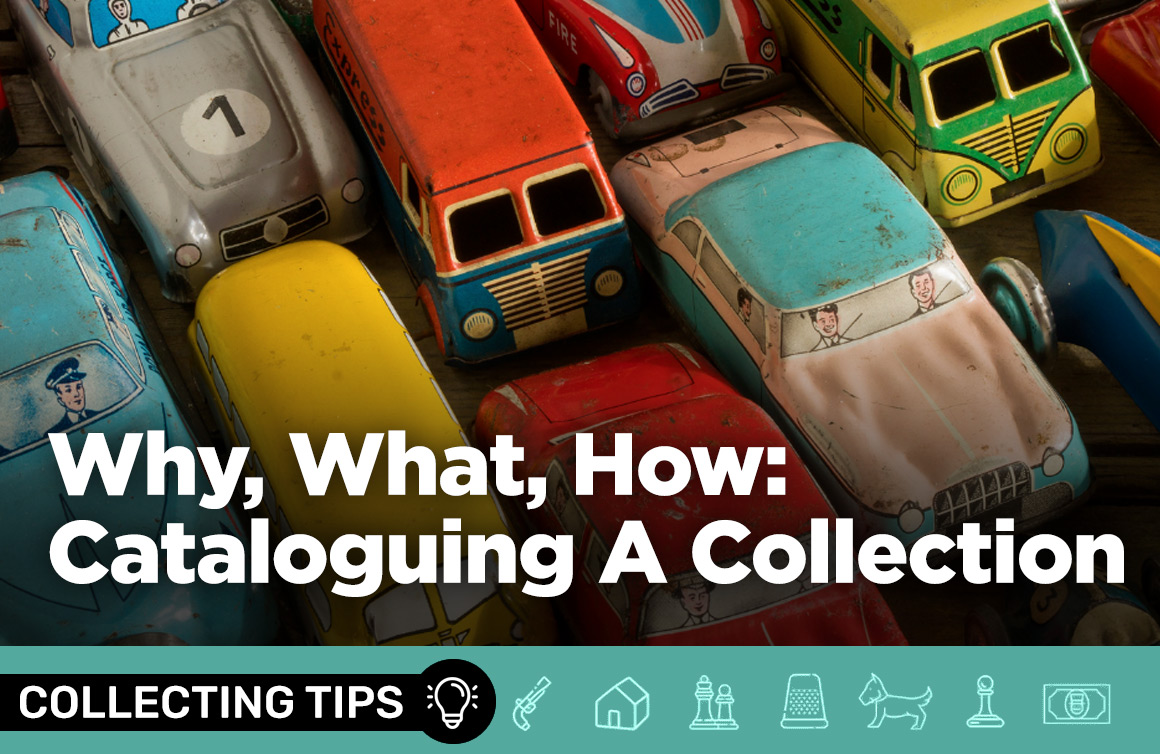Collections evolve over time; they transform from small groups of cherished objects into impressive displays that require significant physical space and mental energy to maintain.
The point at which a small group of objects becomes a full-fledged collection varies from person to person. At some point during this process, many collectors begin to wonder whether they should start documenting their acquisitions. There are many considerations involved in cataloging a collection, but don’t let the task deter you. Answering a few basic questions — why, what, how — can help you get started on the right note.
Why: Determine Your Goal
Why do you want to document your collection?
There are many reasons a collection is worth documenting:
- Insurance policies and claims
- Vying for an official record
- To avoid buying or receiving duplicates
- For your own information and enjoyment
- History preservation and stewardship
- As part of a will
- Selling a bequeathed collection or as part of executor duties
- Easy tracking of loaned objects
- Editing or downsizing a collection
Being aware of your motivation to document a collection can help determine which details to record. Documenting each object in a collection for insurance purposes requires a different approach casually recording details to avoid acquiring duplicate items.
Like your collection, the goal behind documenting the objects may change over time. Having an organized approach to documenting even the most basic details is a helpful foundation.
What: Capture the Details
What details do you want to record?
Knowing your motivation for cataloguing your collection will help determine how much– and which — detail to record. Continuing with the example of insurance, the more details available in estimating the value of a collection offers peace of mind and contributes to being fairly compensated should an unwelcome event occur.
Detailed descriptions, purchase dates, prices, and photos will be helpful in this scenario, whereas a casual collector may find that high-level descriptions and photos are adequate.
Some details to consider documenting:
- Item name
- Manufacturer
- Description
- Material
- Purchase date and location
- Purchase price
- Photos
- Item location (display/storage)
- Other details relevant to the collection type
How: Find the Right Tool
What’s the best tool available for the task?
Being a casual collector has its advantages when it comes to cataloguing a collection because there are free tools widely available to get the job done. The more details there are to record, the more complex finding the right tool might be.
Some options to consider:
- Spreadsheets
Pro: free and widely available
Con: not ideal for adding photographs - Photos on a smartphone shared to a specific album
Pro: smartphones are now common and they are almost always nearby
Con: they aren’t great at documenting other important details - Third-party apps
Pro: purpose-built to suit the needs of collectors
Con: there may be a cost to gain the most robust functionality - Custom-built database
Pro: uniquely suited to a specific collection
Con: requires development expertise and budget
Tips: Look for a tool with customizable fields to make tracking more specific to the collection type. The ability to search by keyword can also be helpful when the need arises to find information within a large collection.
Each tool has its own advantages and disadvantages. Your choice will depend on multiple factors but an important one is usability: you need to be comfortable using it. If it’s cumbersome or confusing, you won’t use it and your efforts to catalogue your collection won’t sustain.
Final Thoughts
I speak with a lot of collectors who sigh in exasperation when the topic of documenting a collection comes up. Some love the process, others do not and are hesitant to start or continue. It can seem a daunting task to begin, but starting when there’s time to undertake it at your leisure means it can be done mindfully and over a period of time. Setting aside an hour each day is much more palatable than trying to document an entire collection in a rush to meet a deadline that you didn’t see on the horizon.
A well-organized database will help you keep track of your collection, make informed decisions about your objects, and protect your investment.

